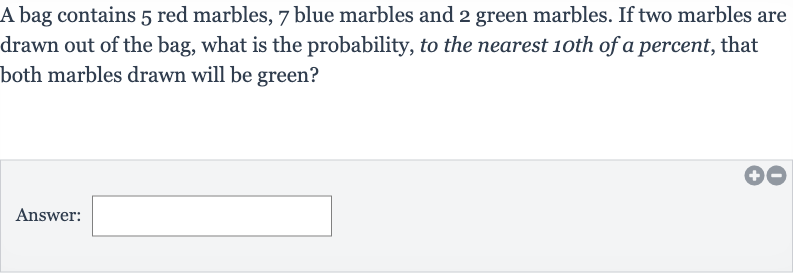AI tutor
Welcome to Bytelearn!
Let’s check out your problem:

A bag contains red marbles, blue marbles and green marbles. If two marbles are drawn out of the bag, what is the probability, to the nearest oth of a percent, that both marbles drawn will be blue?Answer:
Full solution
Q. A bag contains red marbles, blue marbles and green marbles. If two marbles are drawn out of the bag, what is the probability, to the nearest oth of a percent, that both marbles drawn will be blue?Answer:
- Calculate Total Marbles: Determine the total number of marbles in the bag.Add the number of red, blue, and green marbles together. red + blue + green = total marbles.
- Calculate Probability of Drawing: Calculate the probability of drawing one blue marble. Since there are blue marbles out of total marbles, the probability of drawing one blue marble is .
- Calculate Probability of Second Draw: Calculate the probability of drawing a second blue marble after one has already been drawn.After drawing one blue marble, there are now blue marbles left and marbles in total. The probability of drawing a second blue marble is now .
- Calculate Probability of Both Events: Calculate the probability of both events happening together (drawing two blue marbles in a row).Multiply the probabilities of each individual event to find the combined probability..
- Convert Probability to Percentage: Convert the probability to a percentage.To convert a fraction to a percentage, multiply it by .
- Round Percentage: Round the percentage to the nearest tenth of a percent. rounds to when rounded to the nearest tenth of a percent.
More problems from Percent error: word problems
QuestionGet tutor help
QuestionGet tutor help
QuestionGet tutor help
QuestionGet tutor help
QuestionGet tutor help
